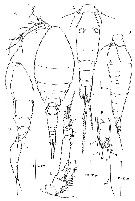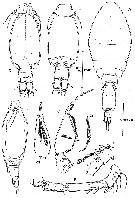|
|
 |
Fiche d'espèce de Copépode |
|
|
Cyclopoida ( Ordre ) |
|
|
|
Oncaeidae ( Famille ) |
|
|
|
Oncaea ( Genre ) |
|
|
| |
Oncaea crypta Böttger-Schnack, 2005 (F,M) | |
| | | | | | | Syn.: | Oncaea ovalis Shmeleva, 1969 (p.11, figs.F; no M) | | | | Ref.: | | | Böttger-Schnack, 2005 (p.179, figs.F,M); Vives & Shmeleva, 2010 (p.279, figs.F,M, Rem.); Böttger-Schnack & Machida, 2011 (p.111, Table 1, fig.2, DNA sequences, phylogeny) |  issued from : R. Böttger-Schnack in Cah. Biol. Mar., 2005, 46. [p.178, Fig.7]. Female (from Adriatic Sea): A, habitus (dorsal, caudal rami seta V missing, arrow indicating \"comb-like\" seta on A1); B, idem (lateral left side); Female (from Eastern Mediterranean Sea). C, urosome (dorsal, left caudal setae IV and V omitted); D, idem (lateral, caudal setae IV and V omitted); E, A1 (modified \"comb-like\" seta on segment 2 arrowed); F, caudal ramus (dorsal, setae IV and V omitted, individual elements numbered using Roman numerals). Nota: Proportional lengths (%) of urosomites and caudal rami 8.3:50.4:11.1:8.9:10.5:10.8. Relative lengths (%) of segments of A1 measured along posterior non-setigerous margin 4.8:15.3:50.7:12.0:4.8:12.4. Anal somite 1.3 times wider than long, about same length as caudal rami. Caudal ramus about 1.4 times as long as wide.
|
 issued from : R. Böttger-Schnack in Cah. Biol. Mar., 2005, 46. [p.180, Fig.8]. Female (from Eastern Mediterranean Sea): A, A2 (lateral elements are numbered using Roman numerals, distal elements are identified by capital letters); B, labrum (anterior); C, idem (posterior); D, Md (showing individual elements); E, Mx1; F, Mx2 (seta on outer margin figured separately); G, Mxp (anterior, claw figured separately) [g, palmar margin, posterior, showing ornamentation details of distal element].
|
 issued from : R. Böttger-Schnack in Cah. Biol. Mar., 2005, 46. [p.181, Fig.9]. Female (from Eastern Mediterranean Sea): A, P1 (anterior); B, P2 (anterior) [b, distal outer margin of exopod-3, posterior, arrows indicating position of pores]; C, P3 (anterior) [c, exopod-3 of another specimen, showing variation in length of outer subdistal spine]; D, P4 (posterior).
|
 issued from : R. Böttger-Schnack in Cah. Biol. Mar., 2005, 46. [p.181, Fig.9]. Female (from Eastern Mediterranean Sea): A, P1 (anterior); B, P2 (anterior) [b, distal outer margin of exopod-3, posterior, arrows indicating position of pores]; C, P3 (anterior) [c, exopod-3 of another specimen, showing variation in length of outer subdistal spine]; D, P4 (posterior).
|
 issued from : R. Böttger-Schnack in Cah. Biol. Mar., 2005, 46. [p.184, Fig.10]. male (from Eastern Mediterranean Sea): A, habitus (dorsal, caudal setae IV and V missing); B, A1 (question mark on segment 4 indicating position of proximalmost aesthetasc, small pit) [b, segment 1, partly , 2 and 3 proximal half, showing comb-like seta on segment 2]; C, Mxp (anterior) [c1, medial view, syncoxa and distal part of claw omitted; c2, palmar margin, posterior view]; D, urosome (dorsal); E, idem (ventral); F, idem (lateral right side, spermatophores not fully developed).
| | | | | Ref. compl.: | | | Nishibe & al., 2009 (p.491, Table 1: seasonal abundance); Böttger-Schnack & Schnack, 2009 (p.131, Table 3, 4) | | | | NZ: | 6 | | |
|
Carte de distribution de Oncaea crypta par zones géographiques
|
| | | | | | | | | | Loc: | | | Sargasso Sea, Medit. (Alboran Sea, Balearic Basin, Adriatic Sea, Dubrovnik, Ionian Sea, Lebanon Basin), Indian (Est equatorial), NW Pacif., Japan, Tosa Bay, Oyashio region, California (off Monterey), ? Washington inland (Dabob Bay) | | | | N: | 5 | | | | Lg.: | | | (933) F: 0,380-0,499; M: 0,330-0,421; {F: 0,38-0,50; M: 0,33-0,41} | | | | Rem.: | meso-bathypelagic.
See the sibling species Oncaea cristata.
For Böttger-Schnack (2005, p.176) the common characteristic of O. cristata and O. crypta is the extremely small size of the outer distal spine on the endopods of P2 and P3, being shorter than the terminal conical projection in both legs. In most other oncaeid species (or -groups) the outer distal spines on the endopods are longer than the projections and thus, the character can be used to separate species of the crypta-cristata-subgroup from other oncaeid species. The only other species exhibiting very small outer distal spines on the endopods of P2 and P3 are O. tenuimana Guisbrecht, 1891 and O. macilenta Heron, 1977, which belong to a different species group within the Oncaidae; however, in this species group the form of the distal endopod segment is much broader and the relative position of the endopodal spines is quite different from those of O. cristata and O. crypta and they can further be separated by differences in other morphological characters, in particular in the mouthparts (Mxp, Md, labrum). | | | Dernière mise à jour : 26/01/2015 | |
|
|
 Toute utilisation de ce site pour une publication sera mentionnée avec la référence suivante : Toute utilisation de ce site pour une publication sera mentionnée avec la référence suivante :
Razouls C., Desreumaux N., Kouwenberg J. et de Bovée F., 2005-2025. - Biodiversité des Copépodes planctoniques marins (morphologie, répartition géographique et données biologiques). Sorbonne Université, CNRS. Disponible sur http://copepodes.obs-banyuls.fr [Accédé le 04 juillet 2025] © copyright 2005-2025 Sorbonne Université, CNRS
|
|
 |
 |







